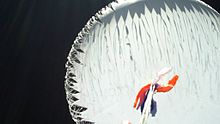 The BLAST high-altitude balloon just before launch on June 12, 2005
The BLAST high-altitude balloon just before launch on June 12, 2005 High-altitude balloons or stratostats are usually uncrewed balloons typically filled with helium or hydrogen and released into the stratosphere, generally attaining between 18 and 37 km (11 and 23 mi; 59,000 and 121,000 ft) above sea level. In 2013, a balloon named BS 13-08 reached a record altitude of 53.7 km (33.4 mi; 176,000 ft).[1]
The most common type of high-altitude balloons are weather balloons. Other purposes include use as a platform for experiments in the upper atmosphere. Modern balloons generally contain electronic equipment such as radio transmitters, cameras, or satellite navigation systems, such as GPS receivers. Hobbyists frequently purchase weather balloons because of its ease of use, low price point, and its widespread commoditisation.
These balloons are launched into what is defined as "near space", defined as the area of Earth's atmosphere between the Armstrong limit (18–19 km (11–12 mi) above sea level), where pressure falls to the point that a human being cannot survive without a pressurised suit, and the Kármán line (100 km (62 mi) above sea level[2]), where astrodynamics must take over from aerodynamics in order to maintain flight.
Due to the low cost of GPS and communications equipment, high-altitude ballooning is a popular hobby, with organizations such as UKHAS assisting the development of payloads.[3][4]
 An example image from a hobby high-altitude balloon launched by the Make Stuff Club from Kalamazoo College
An example image from a hobby high-altitude balloon launched by the Make Stuff Club from Kalamazoo College  A photo taken from a 1,500 g (3.3 lb) weather balloon at approximately 100,000 ft (19 mi; 30 km) above Oregon
A photo taken from a 1,500 g (3.3 lb) weather balloon at approximately 100,000 ft (19 mi; 30 km) above Oregon  A latex weather balloon bursting at about 29.5 km (18.3 mi; 97,000 ft)
A latex weather balloon bursting at about 29.5 km (18.3 mi; 97,000 ft) History
The first hydrogen balloon
In France during 1783, the first public experiment with hydrogen-filled balloons involved Jacques Charles, a French professor of physics, and the Robert brothers, renowned constructors of physics instruments.
Charles provided large quantities of hydrogen, which had only been produced in small quantities previously, by mixing 540 kg (1,190 lb) of iron and 270 kg (600 lb) of sulfuric acid. The balloon took 5 days to fill and was launched from Champ de Mars in Paris where 300,000 people gathered to watch the spectacle. The balloon was launched and rose through the clouds. The expansion of the gas caused the balloon to tear and it descended 45 minutes later 20 km (12 mi) away from Paris.[5]
Crewed high-altitude balloons
Crewed high-altitude balloons have been used since the 1930s for research and in seeking flight altitude records, including Auguste Piccard's flights up to 16,201m, the Soviet Osoaviakhim-1 at 22,000m, and the American Explorer II at 22,066m.[6] Notable crewed high altitude balloon flights include three records set for highest skydive, the first set by Joseph Kittinger in 1960 at 31,300m for Project Excelsior, followed by Felix Baumgartner in 2012 at 38,969m for Red Bull Stratos and most recently Alan Eustace in 2014 at 41,419m.
Uses
Uncrewed high-altitude balloons are used as research balloons, for educational purposes, and by hobbyists. Common uses include meteorology, atmospheric and climate research, collection of imagery from near space, amateur radio applications, and submillimetre astronomy.
High-altitude balloons have been considered for use in telecommunications[7] and space tourism.[6] Private companies such as Zero 2 Infinity, Space Perspective, Zephalto, and World View Enterprises are developing both crewed and uncrewed high-altitude balloons for scientific research, commercial purposes, and space tourism.[8][9] High-altitude platform stations have been proposed for applications such as communications relays.
Amateur high-altitude ballooning
 Payload of an amateur high-altitude balloon for scientific purposes. Embedded computer Arietta G25, custom pcb and different sensors (temperature, pressure, passive radiation detector). Photo taken after the flight.
Payload of an amateur high-altitude balloon for scientific purposes. Embedded computer Arietta G25, custom pcb and different sensors (temperature, pressure, passive radiation detector). Photo taken after the flight. In many countries, the bureaucratic overhead required for high altitude balloon launches is minimal when the payload is below a certain weight threshold, typically on the order of a few kilograms.[10][11] This makes the process of launching these small HABs accessible to many students and amateur groups. Despite their smaller size, these HABs still often ascend to (and past) altitudes on the order of 30,000 m (98,000 ft), providing easy stratospheric access for scientific and educational purposes.[12][3][4][13][14][15] These amateur balloon flights are often informed in their operations by the use of a path predictor. Before launch, weather forecasts containing predicted wind vectors are used to numerically propagate a simulated HAB along a trajectory, predicting where the actual balloon will travel.[16]
You received this message because you are subscribed to the Google Groups "1top-oldtattoo-1" group.
To unsubscribe from this group and stop receiving emails from it, send an email to 1top-oldtattoo-1+unsubscribe@googlegroups.com.
To view this discussion on the web visit https://groups.google.com/d/msgid/1top-oldtattoo-1/CAGNPKmkDsLa%2B9o8ZVpoZtVE_a1v-O_or0Uqq6GMEx4sWsca%3Dew%40mail.gmail.com.

No comments:
Post a Comment